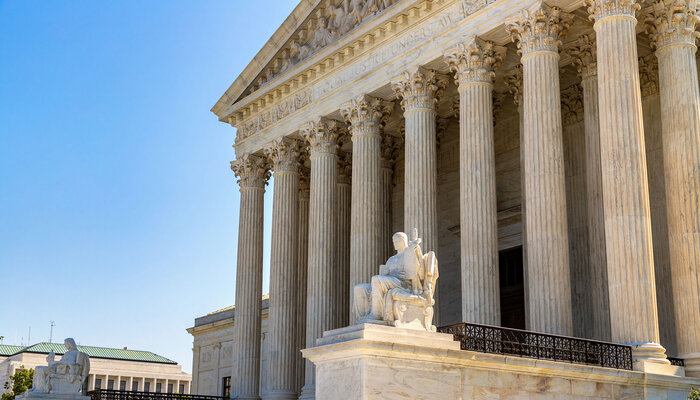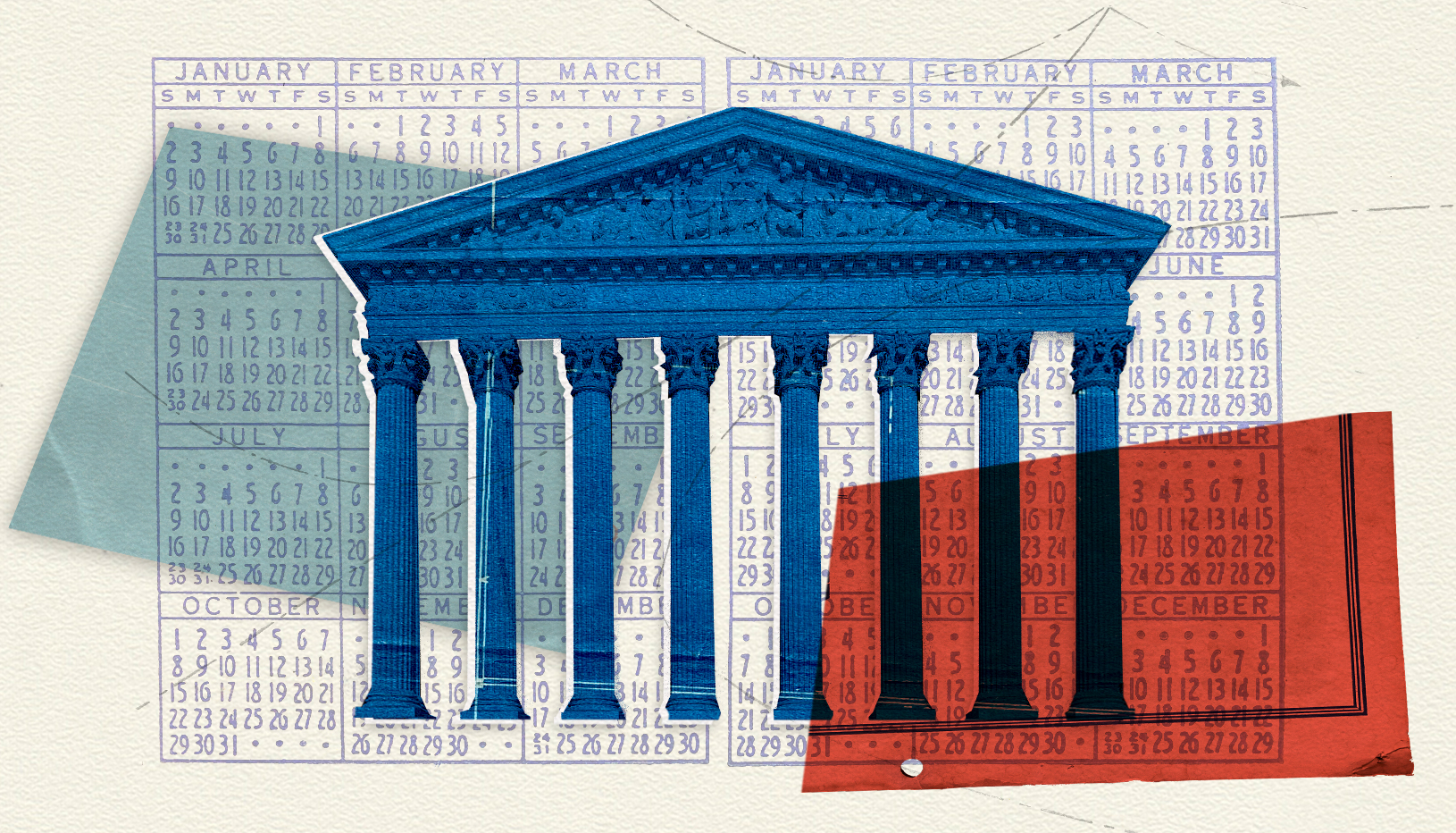This is an excerpt from the Brennan Center report Supreme Court Term Limits.
The Constitutionality of Implementation by Statute
Article III, which structures the judicial branch, is sparsely detailed. Section 1 provides that “the judicial Power of the United States, shall be vested in one supreme Court, and in such inferior Courts as the Congress may from time to time ordain and establish” and that “the Judges, both of the supreme and inferior Courts, shall hold their Offices during good Behaviour, and shall, at stated Times, receive for their Services, a Compensation, which shall not be diminished during their Continuance in Office.” Section 2 enumerates the types of cases and controversies to which “the judicial Power shall extend,” identifies the types of cases under the Supreme Court’s original jurisdiction, and establishes that “the supreme Court shall have appellate Jurisdiction, both as to Law and Fact, with such Exceptions, and under such Regulations as the Congress shall make.” Section 3 discusses punishment for treason.
The value of judicial independence is embedded in this constitutional design. By providing that judges hold their offices during good behavior, the Constitution prevents Congress from ousting judges from office other than through the high bar of impeachment and removal. And by prohibiting the diminution of judicial salaries, the Constitution guards against retaliation by the political branches for unpopular decisions. 1
At the same time, while Article III mandates that there be a Supreme Court vested with “the judicial Power of the United States,” it says remarkably little about how the Supreme Court should operate. Rather, it leaves it to Congress to make significant determinations regarding the Court’s structure and powers pursuant to Article III and its authority to “make all Laws which shall be necessary and proper.” 2
Congress has repeatedly exercised this authority. For example, it has changed the number of justices on the Court six times, with sizes ranging from 5 to 10 justices. 3 It also has substantially changed the Court’s jurisdiction. 4 It was not until 1891, for example, that Congress granted the Court the power of discretionary appellate review. 5 Congress has also altered the duties of justices. For instance, when Congress created circuit courts through the Judiciary Act of 1789, it did not create corresponding circuit judges. Instead, Congress mandated that Supreme Court justices sit alongside local district judges to hear cases in a practice known as circuit riding. 6 In 1803, in Stuart v. Laird, the Supreme Court upheld circuit riding as constitutional, against an objection that the justices had never been separately appointed as circuit judges. 7 Congress maintained this practice for more than 100 years until it became untenable for the justices to fulfill their duties on both circuit courts and the Supreme Court. 8
[. . .]
The active/senior justice model is similar to a long-standing system of senior judges that is more than a century old and that has applied to Supreme Court justices since 1937. The main difference is that under the reform, justices take senior status pursuant to a fixed schedule rather than at a time of their choosing. This distinction has constitutional relevance, however, only if being required to take senior status is akin to being forced from office, such that the justices would no longer “hold their Offices during good Behaviour.” 9
But the Supreme Court ruled nearly 90 years ago that senior judges continue to hold their judicial offices. In 1934, in Booth v. United States, the Court considered a predecessor of the senior judge statute that applied to lower court judges. The Court held that assuming senior status does not constitute a removal from office. Considering a challenge by a senior judge to a reduction in salary, the Court concluded that senior judges could not have their salaries reduced because a senior judge “does not surrender his commission, but continues to act under it.” 10 In other words, senior judges remain judges within the meaning of Article III. The Court explained that “Congress may lighten judicial duties, though it is without power to abolish the office or to diminish the compensation appertaining to it.” 11
Although Booth concerned lower court judges, its reasoning applies with equal force to Supreme Court justices because Article III’s Good Behavior Clause applies to “Judges, both of the supreme and inferior Courts.” 12 While imposing a schedule for when justices take senior status leaves them with less discretion over the content of their dockets, it is Congress, not the justices themselves, that holds the power to define the contours of justices’ dockets and duties.
While the Supreme Court has not squarely addressed the constitutionality of senior judges since Booth, it has affirmed its underlying rationale. In Nguyen v. United States, a 2003 case challenging the constitutionality of an appellate panel consisting of an active circuit judge, a senior circuit judge, and an Article IV territorial judge from the Northern Mariana Islands, the Supreme Court held that the panel lacked the authority to hear the appeal due to the presence of the Article IV judge. But in doing so, the Court confirmed that both the active and senior judge were, “of course, life-tenured Article III judges who serve during ‘good behavior’ for compensation that may not be diminished while in office.” 13 Lower courts have also entertained challenges to the constitutionality of the senior judge system since Booth, including several in recent years. They have consistently held that the senior judge system is constitutional and that arguments to the contrary are without merit. 14
Moreover, there is a long-standing tradition of justices who have retired from active service sitting by designation on lower federal courts, including Justices Potter Stewart, Lewis F. Powell Jr., and Byron White and, in recent years, Justices O’Connor and Souter. 15 Since 1937, retired justices have heard more than 1,300 cases while sitting as judges on the courts of appeal and district courts. 16 If it were the case that justices surrender their judicial office when they retire from active service on the Court, then the practice of justices sitting by designation would itself be unconstitutional. As the Court noted in Booth, “It is scarcely necessary to say that a retired judge’s judicial acts would be illegal unless he who performed them held the office of judge.” 17
Some critics have objected to senior justices by suggesting that the Constitution creates a separate “office” of Supreme Court justice that is distinct from the office of lower court judge. 18 According to this argument, in order to retain their office within the meaning of the Good Behavior Clause, justices must perform duties related to their Supreme Court office. But Congress has broad power to define the content of the office of a justice, including, as Booth recognized, to “lighten judicial duties” over the course of a judge’s tenure and, as Stuart recognized, to require justices to serve on lower courts. Indeed, under the current system, justices who have retired from active service can sit by designation on lower courts but are barred from sitting on the Supreme Court. 19
To be sure, Congress could not “lighten” justices’ duties out of existence altogether such that they held office in name only. Nor could Congress single out an individual justice for lightened duties or target justices appointed by a president of a particular political party. But these actions are forbidden because they are assaults on the values of judicial independence enshrined in the Constitution’s structure. By contrast, the active/senior justice model targets no justice individually and does not impinge on the justices’ decisional independence.
Separately, some critics have objected to senior justice models on the theory that elevating an active justice to senior justice without a separate appointment violates the Constitution’s Appointments Clause. 20 However, under Supreme Court precedent, a change in duties does not require a new appointment so long as the new duties are sufficiently germane to those of the original position. This “germaneness” requirement under the Appointments Clause is quite broad. For example, in Weiss v. United States, the Court held that a commissioned military officer could be designated as a military judge without a separate appointment. 21 It is far from clear that prospectively changing justices’ duties implicates the Appointments Clause.
Regardless, because federal law already authorizes retired justices to engage in the duties with which senior justices would be tasked under the active/senior justice model, it appears clear that a separate appointment is not required. 22
Finally, some critics point to historical practice in objecting to the active/senior justice model. But while it is true that justices have been able to sit in active service until they choose to step down, the fact that earlier generations did not see a need to restructure “good behavior” tenure into active service and senior service does not mean that Congress lacks the authority to do so today. The Constitution leaves Congress with wide latitude to define the Court’s structure and the justices’ duties as required by the needs of the day, constrained by structural protections that preserve judicial independence. As recognized by dozens of prominent constitutional scholars, the active/senior justice model is fully consistent with the Constitution’s text and structure, as well as with longstanding precedent about the operation of senior judges. 23
Endnotes
-
1
As Hamilton writes in Federalist 78, good-behavior tenure “is an excellent barrier to the despotism of the prince; in a republic it is a no less excellent barrier to the encroachments and oppressions of the representative body.” See also Sanford Levinson, “Life Tenure and the Supreme Court: What Is to Be Done?,” in Reforming the Court: Term Limits for Supreme Court Justices, 379.
-
2
U.S. Const. art. I, § 8. See also An Ethical Judiciary: Transparency and Accountability for the 21st Century Courts, Hearing Before the Subcomm. on Federal Courts, Oversight, Agency Action and Federal Rights, 117th Cong. (2022), 455–57 (written testimony of Amanda Frost, Bronfman Professor of Law and Government, American University Washington College of Law), https://www.judiciary.senate.gov/imo/media/doc/Frost%20Testimony.pdf; and Presidential Commission, In Support of a Congressional Statute (written testimony, Amar).
-
3
U.S. Supreme Court, “About the Court: The Court as an Institution,” accessed March 23, 2023, https://www.supremecourt.gov/about/institution.aspx. See also Congressional Research Service, “‘Court Packing’: Legislative Control over the Size of the Supreme Court,” December 14, 2020, https://crsreports.congress.gov/product/pdf/LSB/LSB10562.
-
4
Christopher Jon Sprigman, “Congress’s Article III Power and the Process of Constitutional Change,” New York University Law Review 95, no. 6 (December 2020): 1778–1859, https://www.nyulawreview.org/issues/volume-95-number-6/congresss-article-iii-power-and-the-process-of-constitutional-change. On exercises of Congress’s authority to deny federal courts any power to review certain laws, see Dawn M. Chutkow, “Jurisdiction Stripping: Litigation, Ideology, and Congressional Control of the Courts,” Journal of Politics 70, no. 4 (2008): 1058, https://www.journals.uchicago.edu/doi/abs/10.1017/S002238160808105X.
-
5
Martha J. Dragich, “Once a Century: Time for a Structural Overhaul of the Federal Courts,” Wisconsin Law Review 11 (1996): 73, https://repository.law.wisc.edu/s/uwlaw/item/27661.
-
6
Steven G. Calabresi and David C. Presser, “Reintroducing Circuit Riding: A Timely Proposal,” Minnesota Law Review 90 (2006): 1390–91, https://scholarship.law.umn.edu/cgi/viewcontent.cgi?article=1032&context=mlr.
-
7
Stuart v. Laird, 5 U.S. 299 (1803).
-
8
Calabresi and Presser, “Reintroducing Circuit Riding,” 1406–09.
-
9
U.S. Const. art. III, § 1.
-
10
Booth v. United States, 291 U.S. 339, 350–51 (1934).
-
11
Booth, 291 U.S. at 351, 354.
-
12
U.S. Const. art. III, § 1.
-
13
Nguyen v. United States, 539 U.S. 69, 72 (2003).
-
14
See Bank of N.Y. Melon v. Stafne, 824 F. App’x 536, 536 (9th Cir. 2020); Steckel v. Lurie, 185 F.2d 921, 925 (6th Cir. 1950); Hoang v. Bank of Am., N.A., No. C17–0874JLR, 2021 WL 615299, at *1 (W.D. Wash. Feb. 17, 2021), aff’d, 820 F. App’x 594, 595 (9th Cir. 2020); Rodgers v. Knight, No. 2:13–04033-CV-C-NKL, 2013 WL 12184288, at *1 (W.D. Mo. July 1, 2013), aff’d, 781 F.3d 932 (8th Cir. 2015); Ezor v. Yee, No. CV 22–840 JVS (AGR), 2023 WL 2554162, at *2 (C.D. Cal. Mar. 2, 2023); Stafne v. Burnside, No. C16–0753-JCC, 2022 WL 2073074, at *2 (W.D. Wash. June 9, 2022); Stafne v. Zilly, 337 F. Supp. 3d 1079, 1097–98 (W.D. Wash. 2018); Bluwav Sys., LLC v. Durney, No. 09–13878, 2012 WL 5392301, at *1 (E.D. Mich. Nov. 5, 2012). See also Hon. Betty Binns Fletcher, “A Response to Stras & Scott’s Are Senior Judges Unconstitutional?,” Cornell Law Review 92, no. 3 (2007): 523–32, https://scholarship.law.cornell.edu/cgi/viewcontent.cgi?article=3057&context=clr.
-
15
See E. Jon A. Gryskiewicz, “The Semi-Retirement of Senior Supreme Court Justices: Examining Their Service on the Courts of Appeals,” Seton Hall Circuit Review 11 (2015): 285–326, https://scholarship.shu.edu/cgi/viewcontent.cgi?article=1144&context=circuit_review.
-
16
Gryskiewicz, “The Semi-Retirement of Senior Supreme Court Justices,” 293–98.
-
17
Booth, 291 U.S. at 350
-
18
Under this argument, Article III’s statement that “the Judges, both of the supreme and inferior Courts, shall hold their Offices during good Behaviour” is read to imply that they will hold their respective offices during good behavior. Proponents of this argument further point to the Appointments Clause, which identifies “Judges of the supreme Court” as a category, and to a provision in Article I providing that the Chief Justice shall preside over impeachment trials. See Calabresi and Lindgren, “Term Limits,” 859–68; and Scott Bloomberg, “Reform Through Resignation: Why Chief Justice Roberts Should Resign (in 2023),” Iowa Law Review Online 106 (July 7, 2021): 30, https://ilr.law.uiowa.edu/sites/ilr.law.uiowa.edu/files/2022–11/Reform%20Through%20Resignation-%20Why%20Chief%20Justice%20Roberts%20Should%20Resign%20%28in%202023%29%20.pdf.
-
19
28 U.S.C. § 371(e); 28 U.S.C. § 294(d).
-
20
U.S. Const., art. II, § 2.
-
21
Weiss v. United States, 510 U.S. 163 (1994). See also Presidential Commission, Final Report, 131.
-
22
Presidential Commission, Final Report, 131–32. Prior to serving as a U.S. senator, Josh Hawley endorsed the adoption of Supreme Court term limits by statute because “Article III demands that judges be appointed for life, but it does not necessarily require that Supreme Court justices serve for life — provided they remain judges when not on the Court.” Joshua D. Hawley, “The Most Dangerous Branch,” National Affairs, July 2012, https://www.nationalaffairs.com/publications/detail/the-most-dangerous-branch.
-
23
In 2020, 29 professors signed an open letter supporting a similar statutory proposal. See Fix the Court, “Open Letter of Law Professors Supporting H.R. 8424,” October 23, 2020, https://fixthecourt.com/wp-content/uploads/2020/10/Endorsers-of-H.R.-8424–10.23.20f.pdf. In 2009, 31 scholars sent a letter to then vice president Biden, then attorney general Holder, and the Senate and House Judiciary Committees containing four proposals to include in a potential Judiciary Act of 2009. Among those proposals was one for 18-year terms and regularized appointments. See Eliza Presson, “Group’s Proposals for Supreme Court Reform,” SCOTUSblog, February 16, 2009, https://www.scotusblog.com/2009/02/groups-proposals-for-supreme-court-reform. And in 2005, 45 law professors “in principle” supported another, similar statutory proposal. See Paul D. Carrington and Roger C. Cramton, “The Supreme Court Renewal Act: A Return to Basic Principles,” July 5, 2005, https://perma.cc/D5V3-EXKF. See also Roosevelt, “Court Reform and the Biden Commission”; Michael C. Blumm, Kate Flanagan, and Annamarie White, “Right-Sizing the Supreme Court: A History of Congressional Changes,” Case Western Reserve Law Review 72, no. 1 (2021): 10n4, https://scholarlycommons.law.case.edu/cgi/viewcontent.cgi?article=4942&context=caselrev; Balkin, “Don’t Pack the Court”; Roger C. Cramton, “Constitutionality of Reforming the Supreme Court by Statute” in Reforming the Court: Term Limits for Supreme Court Justices, 359–60; Cramton, “Reforming the Supreme Court”; Paul D. Carrington, “Checks and Balances: Congress and the Federal Courts” in Reforming the Court: Term Limits for Supreme Court Justices, 138–39; Levinson, “Life Tenure and the Supreme Court; Judith Resnik, “Judicial Selection and Democratic Theory: Demand, Supply, and Life-Tenure,” Cardozo Law Review 26 (January 2005): 640–41, https://www.researchgate.net/publication/228177231_Judicial_Selection_and_Democratic_Theory_Demand_Supply_and_Life-Tenure; and Presidential Commission, In Support of a Congressional Statute (written testimony, Amar).







